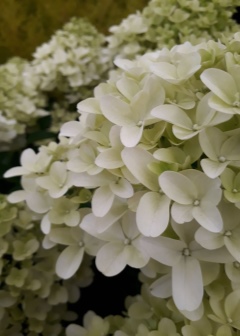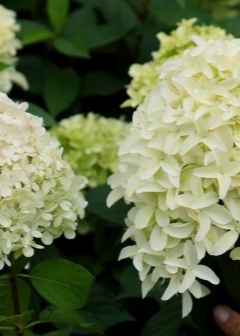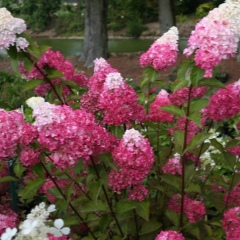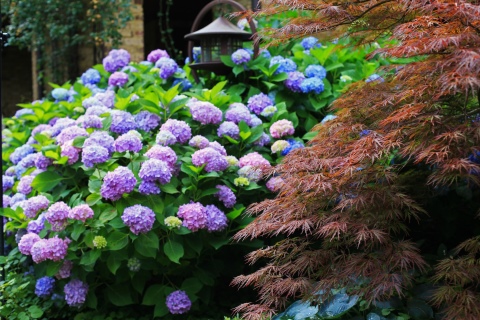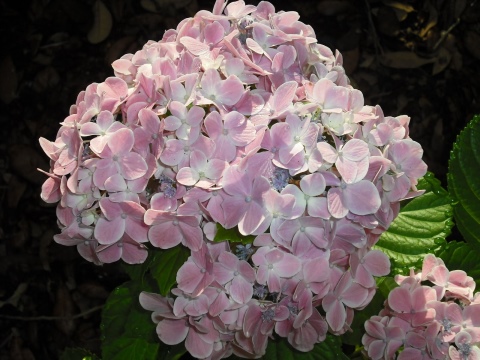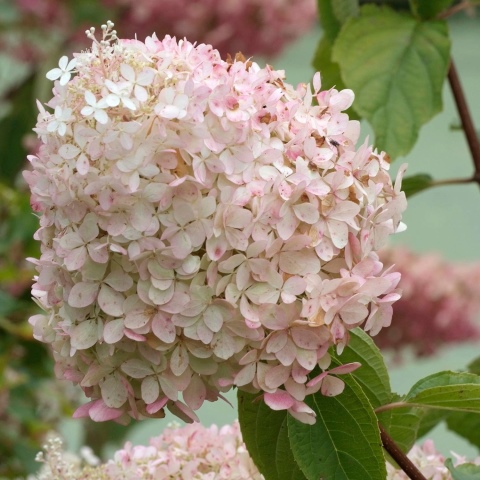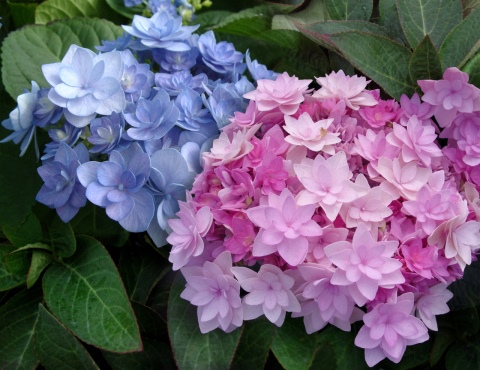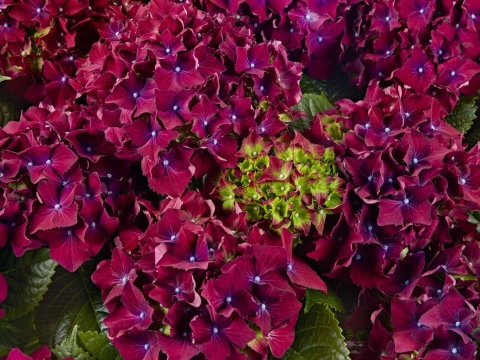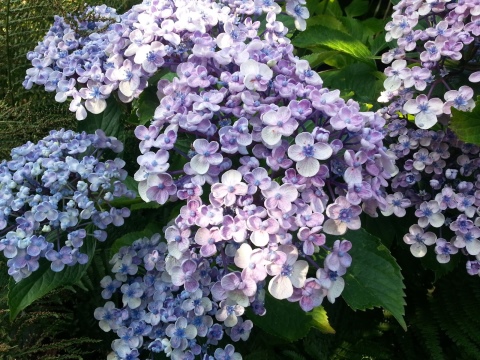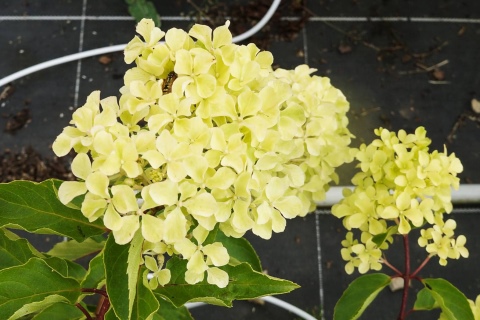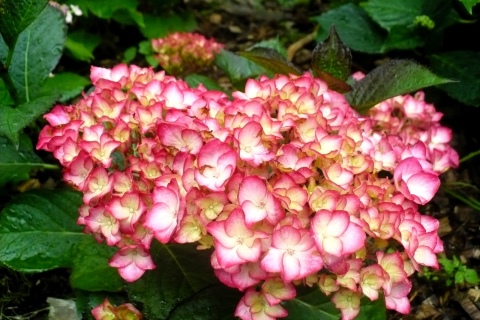How to take care of it properly?
Caring for "Diamond Rouge" consists of regular watering, loosening, mulching, fertilizing and preparing the plant for winter.
Watering
Hydrangea of this variety is very moisture-loving and needs frequent watering. This should be done at least once a week, and in an arid climate and high temperatures, watering is increased up to two times. The amount of water is calculated depending on the type of soil and air humidity, and in hot dry weather is 30 liters per square meter of land. In the rainy period, moisture is reduced and guided by the state of the soil in the near-trunk circle.
Top dressing
Adult bushes "Diamond Rouge" are fed 3 times a season. The first feeding is carried out in April, introducing complex preparations with a high nitrogen content at the root. In the summer, closer to flowering, phosphorus preparations or compositions for flowering plants are introduced, in the absence of which you can get by with superphosphate or potassium sulfate.
The third feeding is performed in September, watering the hydrangea with a mullein solution or phosphorus-potassium compounds, thus preparing the plant for winter and allowing it to make a supply of nutrients necessary for wintering.
Application of liquid fertilizers is performed immediately after watering, but not instead of it. Otherwise, there is a risk of burning the roots, which will lead to flower disease. As for foliar dressing, gardeners recommend treating the leaves with iron chelate, combining it with mineral preparations, depending on the season: in the spring - with nitrogen, in the summer - with phosphorus-containing and in the fall - with potassium compounds.
When choosing a fertilizing agent, you need to know that it is undesirable to bring ash under the Diamond Rouge bush. This is due to the fact that ash reduces the acidity of the soil, which can lead to a loss of brightness of the inflorescences. To reduce the fragility of the bushes 2-3 times per season, it is recommended to spill the hydrangea with a weak solution of potassium permanganate.
Pruning
Hydrangea "Diamond Rouge" needs regular pruning. The procedure is carried out in the spring before the start of sap flow, shortening the shoots by 2/3. Pruning provokes abundant and prolonged flowering, its absence can lead to the cessation of flowering. In the process of pruning, dry, damaged, thickening branches growing inside the bush are removed. If the timing of pruning was missed, then you can wait for the foliage to bloom and shorten last year's shoots by 3-4 large buds.
Spring pruning is best done at the same time as the first feeding. When pruning in autumn, old and weak branches are removed, leaving no more than 12 healthy stems in the bush, as well as dry inflorescences, which may not withstand the weight of the snow and lead to breakage of the shoots. For complete rejuvenation of the old bush, all branches are cut at the root. The complete recovery of the plant occurs in 2 years.
Wintering
Despite its excellent frost resistance, it is better to insulate "Diamond Rouge" for the winter. If the plant grows in a warm climate, then it is high enough to huddle the bushes and cover the near-stem part with rotted manure. In cold climates, the branches of the bush are bent to the ground, fixed with a bracket and covered with spruce branches. Young plantings are additionally tied with a rope, after which they are carefully bent to the ground, fixed, sprinkled with sawdust, covered with spruce branches, and, if necessary, covered with non-woven fabric.
Adult tall plants are not folded down, but only wrapped in lutrasil, which is fixed with tape.Then a metal frame is installed around the bush, the trunk circle is covered with dry foliage and covered with plastic wrap. At the onset of the first thaws, the shelter is dismantled, preventing the bush from rotting.
Landing
The large-leaved Endless Summer hydrangea has several advantages over other varieties:
- frost resistance: plants can survive cold weather down to -30 ° C;
- bloom observed in spring and summer, so this period is 3 months longer than other varieties.

Planting hydrangeas must be done in the right place and under the right conditions. If you carry out the procedure, adhering to all the recommendations, then by next year you will be able to enjoy the beautiful flowering bushes.
Seat selection
Finding the right place to plant is very important. If you will plant planting material in the northern part of the site, then you need to do it in open areas.
Plants need to get enough heat and light from the sun.

Planting on the south side of the garden requires protecting shrubs from direct sunlight. The soil for planting should be nutritious, but with a medium acid and alkali level (5 to 7.5). The distance between the bushes should be such that they do not touch each other.
Soil preparation
The soil should be moistened, but not very much, therefore, a month before the intended planting (it can be carried out in spring and autumn), you need to dig up the area and apply fertilizers (humus or peat). 4 buckets of nutrients are scattered on 1 m². After that, the soil is watered with water, at the rate of 50 liters per 1 m².

You need to mark the site a week before planting. Holes measuring 50 × 50 cm are dug at a distance of 2 m from each other. If the groundwater comes closer than 2 m to the ground, then a drainage system must be installed. To do this, use expanded clay or crushed stone. The drainage layer should be about 20 cm.
Planting process
The landing technology is as follows:
- Sprinkle the drainage layer with nutritious soil. To do this, mix garden soil with peat (in a 2: 1 ratio) and add 100 g of superphosphate.
- Place the seedling inside the hole and spread the roots.
- Dig in a metal rod 30 cm above the seedling next to it. Tie a plant to it.
- Sprinkle soil over the hole and pour 30 liters of water.
- Compact the soil so that no voids form in the root system.
- Mulch with a 20 cm layer of humus or peat.

When growing hydrangea varieties Endless Summer, you need to properly care for it. You will need to apply fertilizers in a timely manner, water the bushes and prepare them for winter. Also, do not forget about loosening the soil and removing weeds along with the roots. Such simple actions will not only improve the appearance of the plant, but also protect against diseases and pests.
Watering
Shrubs should be watered sparingly. If the soil is excessively moist, then the number of flower ovaries on the plants will decrease.
Determine the required amount of water based on the type of soil:
- no more than 20 liters of water per 1 m² are poured into clayey lands;
- in sandy ones - at least 30 liters of water per 1 m²;
- in loamy - about 25 liters per 1 m², given that it retains moisture well.

If you have planted a large number of hydrangeas, it is best to irrigate the area with a hose that has many holes in it. You can also install drip irrigation to distribute moisture evenly.
Top dressing and fertilizers
Top dressing is applied in late spring and early summer. Phosphorus is required to stimulate the activity of the flower. 70 g of this substance is applied under each bush. To provoke abundant flowering, you need to add potassium nitrate. One plant is fertilized with 50 g.
Pruning
Only those bushes that are more than 3 years old are cut off. In autumn, old and damaged shoots are removed, thereby activating the growth of young branches.It is not necessary to cut off faded flowers, since they protect the plants from freezing. They need to be harvested in the spring so that new buds form.

Warming for the winter
Despite the fact that the hydrangea of the Endless Summer variety belongs to winter-hardy crops, the plants need to be covered for the winter. If this is not done, then it will be difficult for shrubs to recover from the cold season.

They protect the hydrangea at the end of October, long before the onset of the first frost. To do this, use a shelter in the form of a plastic wrap. You can also cover branches that are closer to the ground with fallen leaves or huddle with peat.
Possible problems
If hydrangeas turn yellow, it can be assumed that the reason is a lack of light (or, conversely, excessive insolation). Yellowing associated with improper lighting is eliminated by transferring the plant to another place or creating the necessary conditions artificially. Sometimes yellowness is provoked by excessive moisture. In this case, the irrigation frequency is immediately reduced. In the future, you just need not to make such mistakes, and the problem will be eliminated.
Sometimes they encounter another defect - when the hydrangeas turn pale. To cope with a situation in which the leaves of an ornamental plant brighten, it is mainly the competent use of fertilizers that helps. It is likely that something was done wrong with them. Especially a lot of feeding is required during budding.
Because of this, it is not always possible and necessary to treat it. You must first check how mature this or that bush is. The formation of ovaries can be expected only in the second year of life. In addition, it must be remembered that an exotic guest can be drowned out by nearby trees. Another nuance - good color development is possible only on:
- loosened;
- containing a sufficient amount of nutrients;
- thoroughly moistened soil (sometimes, for the same reasons, the culture even grows poorly).
Reproduction
It is not necessary to purchase young seedlings. You can grow them yourself. The Summer Snow hydrangea reproduces in several ways:
- cuttings;
- layering;
- dividing the bush.
To implement the first method, it is necessary to start cutting cuttings from the bush in the 20th of April. Preference is given to green shoots, the age of which does not exceed a year. The length of the cuttings should be at least 10 cm. When cutting the shoots, it is necessary to obtain a right angle. The foliage that is located below is removed.
Note! All cut shoots are treated with root roots and planted in fertile soil in a greenhouse
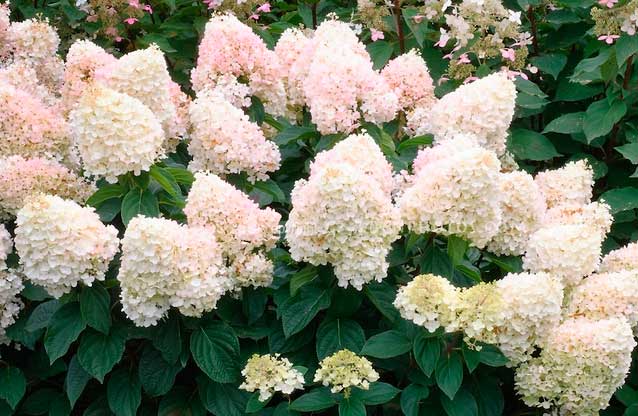
Amazing bloom
In the cold season, the cuttings method can be carried out as follows:
- In the last days of October, dig up the parent bush and transplant it into a spacious container.
- Place the perennial in a room where the temperature does not drop below 6 ° C.
- By the end of winter, the shoots ripen, and cuttings can be cut from them (each should have two internodes).
- Trim the top green mass and cut off the bottom foliage.
- Treat the lower cut of each cutting with a growth stimulant.
- Plant blanks for seedlings in deep containers filled with nutritious soil. Cover the cuttings with jars.
Dividing the bush
Often, in order to obtain a seedling of the Summer Snow variety, flower growers use the method of dividing the bush. Having dug up the parent bush, you need to divide the perennial into several parts. Each division must contain a renewal bud. The resulting bush is planted in a prepared planting recess.
Layers
It is necessary to bend young shoots to the soil surface and dig them in. It is advisable to carry out the procedure in the 20th of October. The tops should remain on the surface of the ground. Their length should be 19-20 cm. Rooted shoots appear at the end of March. They must be separated from the bush and transplanted.
How to determine the type and variety of hydrangea
How to determine if this is a tree that looks like a hydrangea, or a really luxuriantly blooming beauty? You can determine this or that variety by the shape of the leaves. For example, the panicle variety has long and hard elliptical leaves, the leaf blade of the hydrangea has a tree-like large ovoid shape with a heart-shaped notch at the base, there is also a narrow-leaved variety - a rough hydrangea, its leaf shape has a serrated edge, strongly bent back.
Advice. You can also identify a particular variety by inflorescences. Varietal hydrangea and panicle are covered with white caps of inflorescences; in a large-leaved beauty, they can be pink, blue, crimson tones. The paniculate species has large cone-shaped inflorescences.
Every gardener can try to plant a beautiful perennial on his site, discover the wonderful world of aromatic flowering ornamental plants.
Landing
Whichever variety of large-leaved hydrangea is used, it is very important to plant it correctly. This plant is extremely finicky.
It is impractical to plant hydrangeas near a tree, as it will take away too much valuable moisture. It is noted that under constant sunlight, the plant:
- grows more slowly;
- loses the attractiveness of its leaves;
- reduces the size of inflorescences.
It is much better if the sunlight only touches the plant in the morning. Therefore, hydrangeas are planted in the east or west of the site. Certain varieties are allowed to be planted in light zones, but then the excessive brightness of the sun will have to be compensated for by intensive watering. When the heat hits, light shading is required. At the same time, it is unacceptable to place bushes where drafts are constantly blowing.
The soil must be well drained. The culture grows well on clay soil with an abundance of nutrients. But on sandy ground, she does not feel well. The earth is necessarily acidified to prevent chlorosis. For acidification, it is recommended to use soil collected under coniferous plants.
Experts advise purchasing container seedlings, since a plant with open roots does not take root well enough. The best period for planting in cold areas is considered the first decade of May.
Important: you need to be guided not only by the calendar, but also by the fact that the snow melts and the earth is warmed up. In the south, if there is confidence in sufficient warmth, planting can be done in the autumn months.
At the same time, it is undesirable to postpone work until November, otherwise the culture will not take root until the cold weather begins.
The planting soil is:
- 2 shares of leafy land;
- 2 shares of humus;
- 1 share of sod land;
- 1 share of washed river sand.
During planting, add to the soil mixture:
- 0.02 kg of urea;
- 0.07 kg superphosphate;
- 0.025 kg of potassium sulfate.
The planting hole is dug 0.4 m deep, 0.4 m wide and 0.5 m long. A gap of 1.2-1.6 m is left between the bushes. In acidic, nutrient-rich soil, the excavation is made smaller, in poor soil, it is increased in depth and in diameter. With the close proximity of soil waters, a drainage layer is formed, which is created with the help of:
- gravel;
- expanded clay;
- brick battle.
Excessively dry soil is improved by laying a hydrogel. 30 ml of this substance is enough for 1 planting pit. You need to dig it 14-28 days before planting, then fill it with the prepared substrate. Then the soil will have time to settle and be filled with oxygen. The seedling removed from the pot is watered, and then laid in a mound, inside which it is more convenient to spread the roots.
When backfilling, the soil is immediately compacted. The root collar is held either at ground level, or 0.02-0.03 m above it. The planted hydrangea is immediately watered, spending 9-10 liters of water. To retain moisture in the near-trunk circle, sawdust, bark and peat are used. The mulch layer should be 0.06-0.08 m.
Varietal variety and their shades
Beautifully flowering varieties of hydrangea invariably attract the attention of fans of garden and landscape design. Luxurious terry and royal, dwarf and tall, delicate lilac, white, pink, green and multi-colored varieties look incredibly beautiful in the design of the infield
To better understand the whole variety of these shrub plants, you should pay attention to their decorative properties.
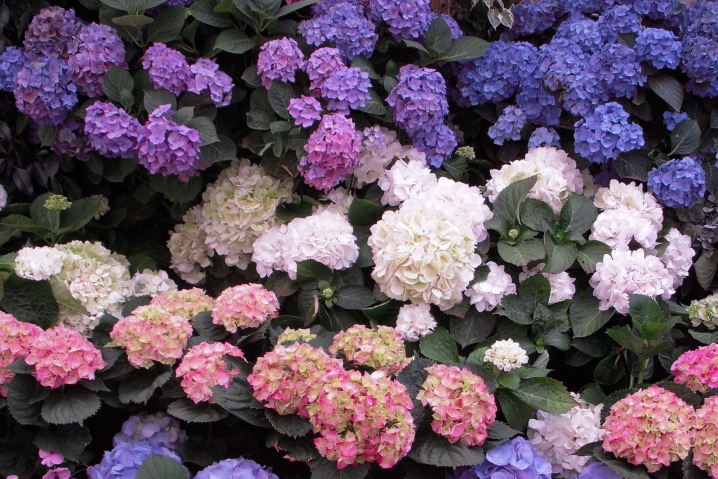
White
Lush snow-white inflorescences, similar to sea foam, and a delicate sophisticated aroma - this is how novice growers usually imagine hydrangeas. Do not be disappointed - many varieties do have milky petals. Let's see which ones have gained the most popularity.
Summer Snow. A low-growing variety belonging to the type of panicle hydrangea. The bush grows no more than 80 cm in height; on dwarf shoots, lush panicles of inflorescences with large petals look especially impressive. The variety is very popular for growing in pots and containers.
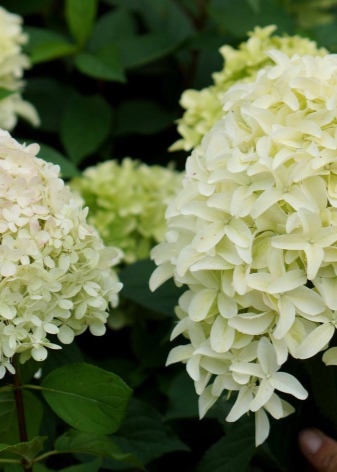
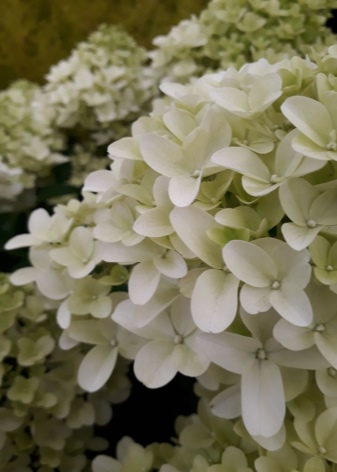
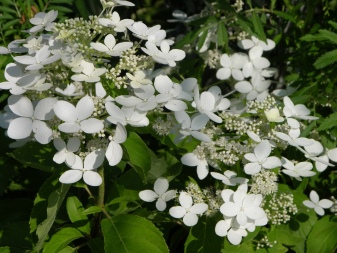

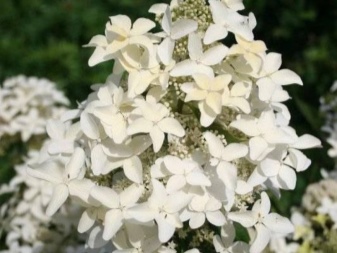
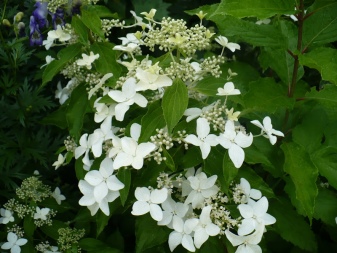
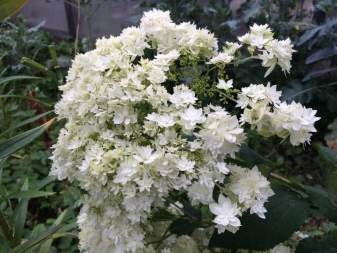

Colored
Colored hydrangeas are very popular, but few people know that the lilac or blue color of petals that looks spectacular in catalogs often depends on the type of soil and the original shade. For example, rose petals can become tender-violet if the plant is regularly (every 10 days) watered with a solution of potassium alum at a concentration of 0.5%. In a similar experiment with white varieties, the shade of the petals will change to blue.
In addition, planting on soils with high acidity, fertilizing the soil with coal ash or iron salts can show a cobalt shade.
Royal Red. The variety of hydrangea is large-leaved, it grows up to 2 m, the crown is wide, spherical. "Royal red" - this is how the name sounds in translation, the plant belongs to shrubs with medium frost resistance, which are recommended for shelter for the winter. Long-lasting flowering, begins in July and ends in late autumn. The variety has a rare and pure scarlet shade of petals that do not change their color, umbrella inflorescences, very decorative.

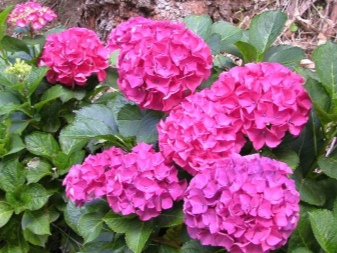

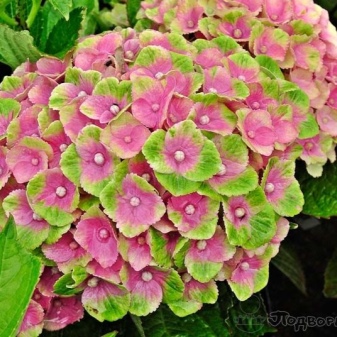
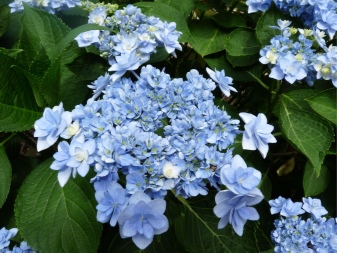
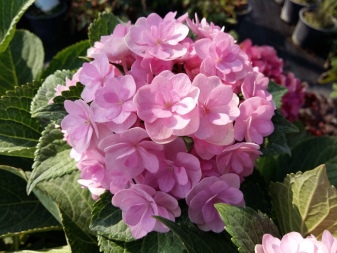
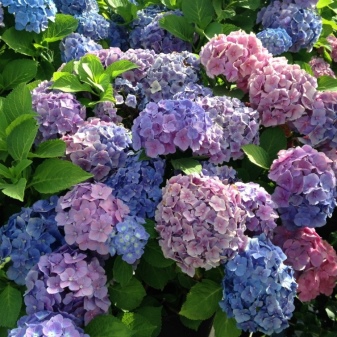
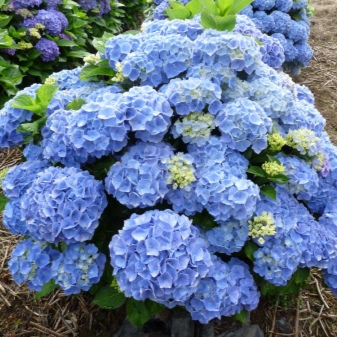
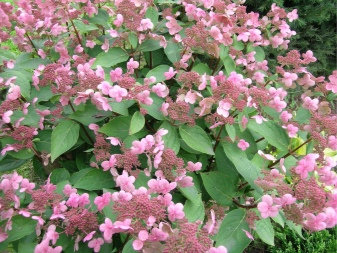
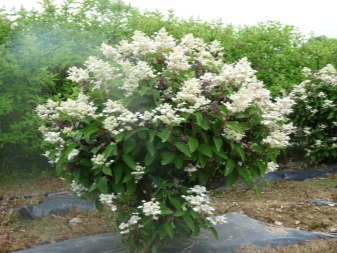
The pink color is not uniform, the petals have different shade variations. The inflorescences are well shaded by the rich green color of the leaves. The variety is suitable for container cultivation, decoration of balconies and terraces, grows best in sunny and semi-shady places.
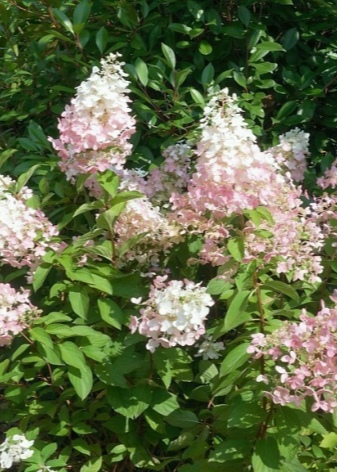

Hydrangea "Big Ben" has a high winter hardiness, but does not like windy areas. It grows well in the sun and in partial shade, the best soil will be neutral or slightly acidic. Awarded by the Royal Horticultural Society for its merits, it is resistant to diseases and pests. The shrub is actively used in landscape design: in single and group plantings, as well as when creating general compositions with flowering perennials.
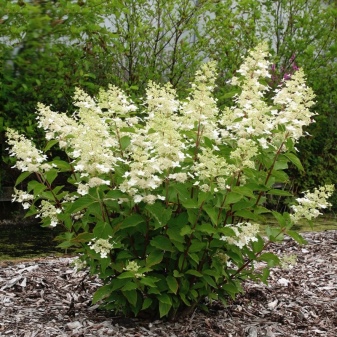
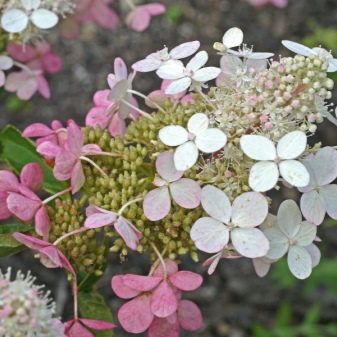
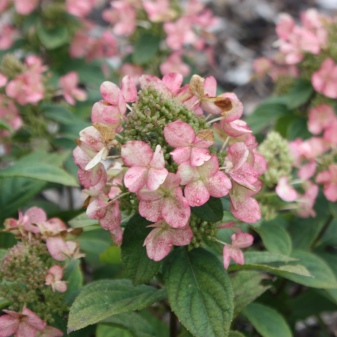

Hydrangea "Diamant Rouge" forms a lush, widely growing bush - at a height of 150 cm, it can reach a width of 200 cm. The variety is winter-hardy, withstands frosts down to -40 degrees, the flowering period is short - from July to August.
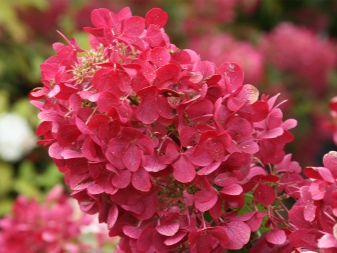
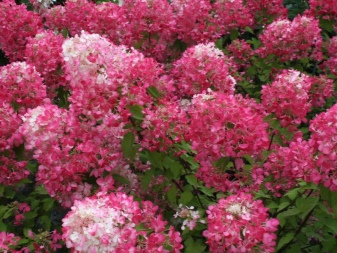
Often the hydrangea is multi-colored until the colors of the petals have changed. The variety "Weems Red" is distinguished by a bright honey aroma and long flowering - from July to October, is a real decoration of the garden.
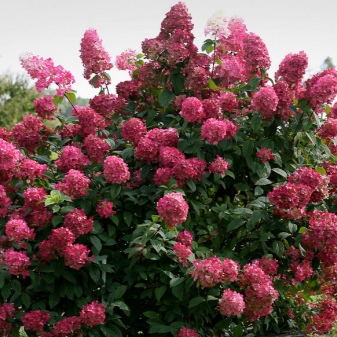
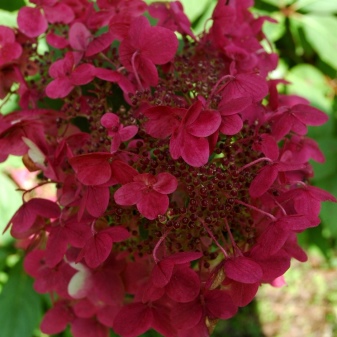


Hydrangea "Miss Saori" belongs to varieties with poor winter hardiness - it is fatal for it to drop temperatures down to -18 degrees. In cold regions, only container growing is recommended. Long bloom, from June to September.

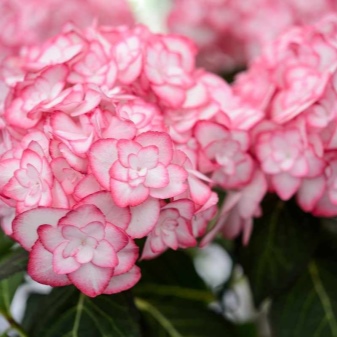

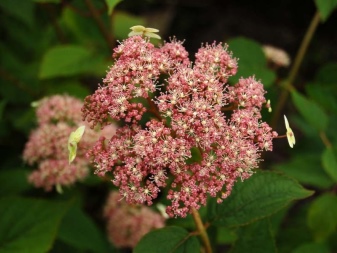
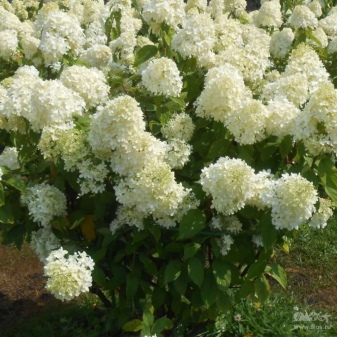
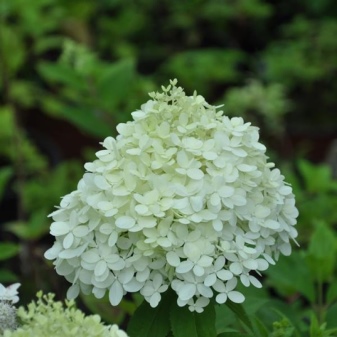
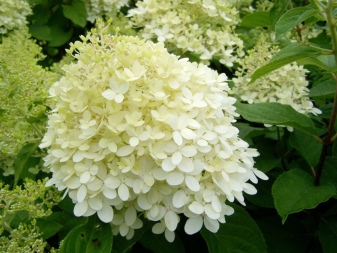

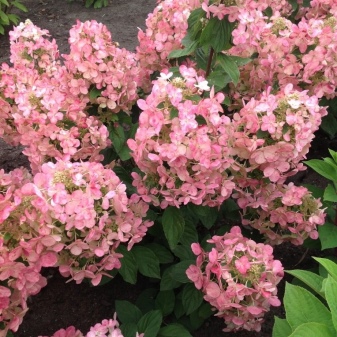
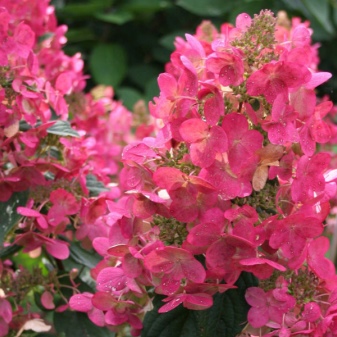
At first, the petals are white, but rather quickly acquire pink, red, and in late autumn and crimson color, they keep their shape to the end without dropping. Very strong shoots of a red-brown shade do an excellent job of maintaining the inflorescences, do not require additional support. The variety is suitable for planting in the sun or in partial shade.
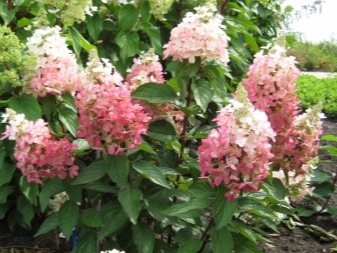
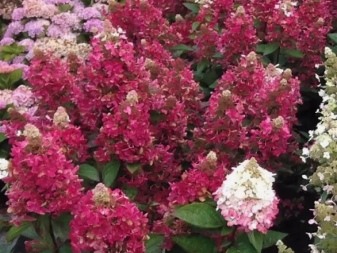
The variety is quite unpretentious, it can winter without shelter.Duration of flowering is from July to October.
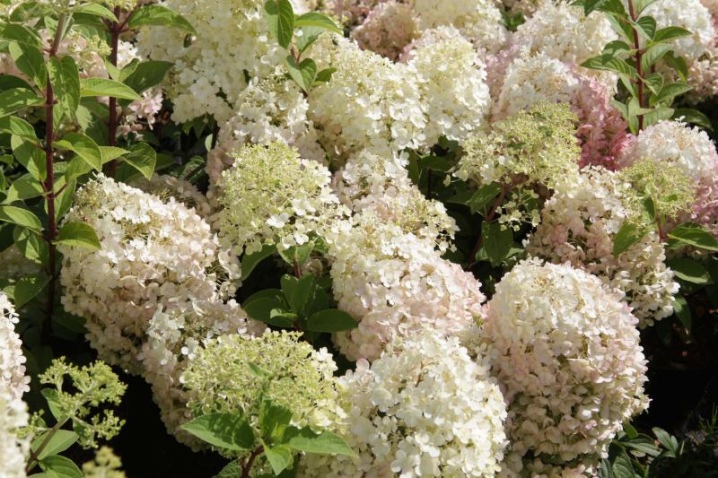
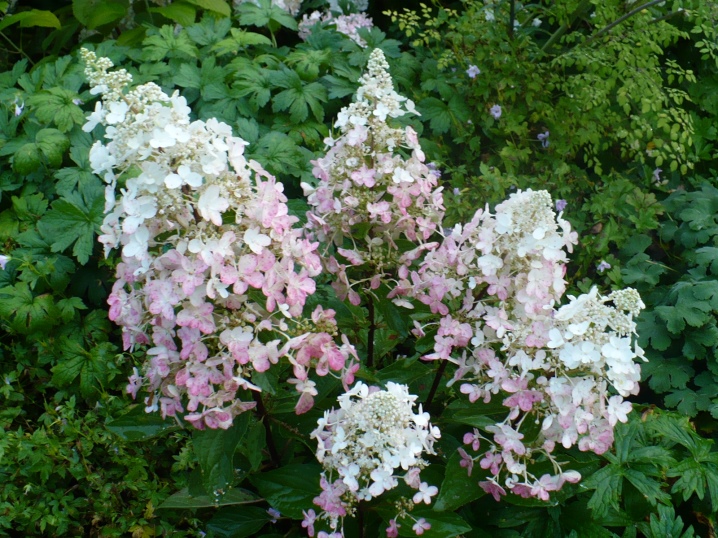
Mature flowers have a bright blue eye in the center; on acidic soils, it can occupy most of the petal. Hydrangea "Schloss Wackerbart" gives buds on the shoots of the current and last year, to stimulate early flowering, it is recommended to cover the plant for the winter.
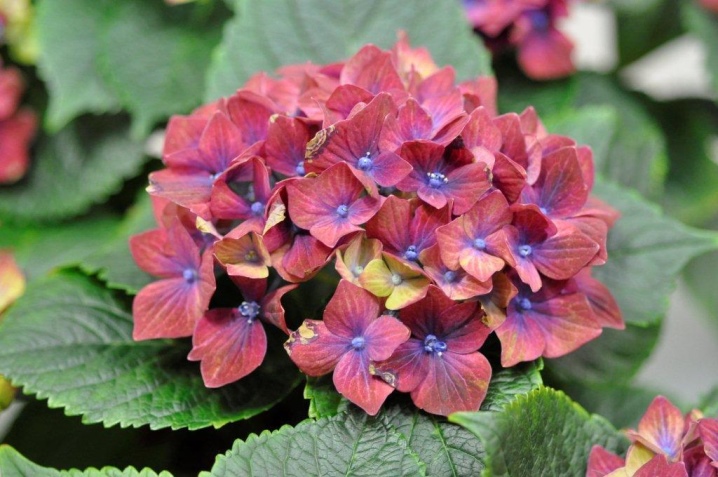
On the lush crown, racemose inflorescences of dark pink color are formed. Retains decorativeness only when planted in the sun. Buds are formed on the shoots of the current year, you can carry out form-building pruning.

Planting and caring for hydrangea Pastel Green
A distinctive feature of this variety is its unpretentiousness to growing conditions. Almost any soil is suitable for Pastel Green, like all ornamental plants, it prefers substrates rich in humus. The more fertile the soil, the less fertilizers and additional food will need to be applied in the future.
In order for the hydrangea to be healthy and bloom magnificently, you must follow a few simple rules:
- regular watering;
- timely introduction of complementary foods;
- periodic pruning of shrubs;
- correct landing in open ground;
- protection against diseases and pests.
Regular care of Pastel Green is a guarantee of lush flowering of the plant
To protect an adult plant from weeds and retain moisture in the soil, experienced gardeners recommend periodically mulching the near-stem circles with Pastel Green. Moss, sawdust or chopped bark of deciduous trees are best suited for these purposes.
Selection and preparation of the landing site
A correctly chosen planting site is the key to a beautiful and healthy plant. Places completely closed from the sun should be avoided. Experts do not recommend planting Pastel Green in shaded outbuildings and fenced areas.
In order for the shrub to please with abundant flowering, it is necessary to find the perfect balance of the sun. Despite the fact that the hydrangea is not too demanding on him, it is best to plant it in open areas. Prolonged exposure to sunlight does not spoil the color of the leaves and, with proper watering, does not affect the development of buds in any way.
Since the shrub has a crown that is not too developed relative to other plants, it must be protected from the wind. It is best to combine planting hydrangeas with small trees or shrubs. If the area is too windy, you can install additional protective screens.
Landing rules
The best time to plant Pastel Green is in early spring. It must be performed after all the snow has melted and before the first buds swell. To do this, dig small planting holes 40x40x40 cm. It is best to prepare them in advance in the fall.
Saplings should have developed branches and a deep root system.
Before planting, it is necessary to inspect the root system of the hydrangea. Damaged areas are removed with pruning shears. After that, the seedlings are placed in pits and dripped with a layer of earth mixed with peat and ash in a ratio of 3: 3: 1. Each seedling is additionally treated with a growth stimulant for faster rooting.
Watering and feeding
Hydrangea Pastel Green does not require a lot of water. It is enough to water the bush once a week. In excessively dry weather, this operation can be performed every 3-4 days. On average, 5-7 liters of water are poured under each bush. Watering is carried out directly on the trunks.
Pastel Green can easily withstand short-term droughts of up to 1-2 weeks. At the same time, she is very negative about excess moisture. With an insufficient drainage layer, accumulated water can cause rotting of the entire root system.
The health of the hydrangea can be maintained with periodic fertilization. It is best to do this either before or after flowering. At the end of September, mineral fertilizers based on potassium and phosphorus are applied under each bush.After the snow melts, each hydrangea is fed with 20 liters of water mixed with 40 g of urea.
Pruning Hydrangea Pastel Green
Most flowering shrubs need periodic crown thinning. This ensures that the shoots develop properly and also helps to form lush branches. The very first pruning of the year is sanitary. Once the snow has completely melted, it is necessary to inspect the hydrangea for frozen shoots and dead branches. They are completely removed to healthy wood.
The next type of trimming is formative. It aims to obtain a lush crown. The procedure is carried out on young plants, leaving only strong, even branches. As soon as Pastel Green is finally formed, you can periodically perform anti-aging pruning - adult branches are removed annually by 3-4 buds.
Preparing for winter
The artificially bred Pastel Green survives the winter perfectly in the conditions of central Russia. But so that sudden temperature fluctuations do not damage the roots or branches of the plant, it must be prepared for the onset of cold weather. The first step is to dig up the trunks and increase the layer of mulch used.
If winter is planned with little snow and cold, it is recommended to additionally insulate the hydrangea bushes. They are wrapped in spunbond or roofing felt and tied with twine or thick clothesline. This will provide additional protection from wind and freezing of branches.
New items in the world of hydrangeas: hybrid varieties
Breeders are making a lot of efforts to please fans of unique plants with new products, for example, recently a multi-colored hydrangea has appeared, combining a unique unusual color with unpretentious care. Samara Lydia is a plant with bright ruby inflorescences, ideal for landscape composition. The height of a compact bush is up to 1 meter, width is about 1.2 meters. The leaves are rich green.
The bright red flowers of the Weems Red shrub will be a real decoration of any site. The variety is unpretentious in care and survives even severe frosts well, is resistant to diseases and major pests. The average height of the bush is 2 meters.
Note! Hybrid varieties, including early flowering ones, are moisture-loving, but you should not fill in the plantings, otherwise gray rot may develop. Little Fraze compact panicle hydrangea with white-pink flowers
Suitable for growing in a pot, since it rarely exceeds 80 cm in height.Caring for this undersized hydrangea is quite simple
Little Fraze is a compact panicle hydrangea with white-pink flowers. Suitable for growing in a pot, since it rarely exceeds 80 cm in height. Caring for this undersized hydrangea is quite simple.
Skyfall is a hybrid paniculate variety with yellow-white petals and cone-shaped inflorescences. Planting in open ground in a place well-lit by the sun is allowed.
The snow-white Skyfall hydrangea blends well with many flowering crops
Hydrangea transplant
Before purchasing a seedling, you must go to the garden to choose a place for planting. It is advisable to choose such a zone so that the main period of time the plant is in the shade, but in the morning hours and after 16.00 the bushes are illuminated by the sun's rays
It is important to systematically moisten the soil around the planted perennials. It should also be borne in mind that in the southern region, seedlings planted in the open sun may die.
Important! Abundant flowering can be achieved only when the bushes receive a sufficient amount of sunlight. In the shade, hydrangea will not delight with lush flowers.
If you want to create an alley of hydrangeas and plant bushes along the garden paths, then you need to retreat from them about 90 cm and only in this place dig a depression. This will allow sprawling bushes to keep out of the way.If, nevertheless, the branches of the bush have gone beyond the boundaries of the path, it is worth tying them up with a rope.
Hydrangea is not planted close to the tree, as the plants will not be able to get enough nutrients. Soon one of them may not only get sick, but also die.
Changing the shade of colors
Soil for planting
The soil for planting should be loose and fertile. Summer Snow panicle hydrangea grows exclusively on slightly acidic ground. Experienced florists recommend preparing the planting recess in advance. This will allow you to independently create a slightly acidic substrate. For this purpose, it will be necessary to fill the pit by a third with sour brown peat. Also, a small part is added to the pit:
- sawdust of coniferous trees;
- forest soil;
- fertile soil;
- pine bark.
Note! A small percentage of compost or humus and 70 g of superphosphate, 20 g of potassium sulfate and 20 g of urea are added to the mixed substrate. The mixed substrate should stand for at least a few days before planting.
The size of the planting recess depends on the characteristics of the seedling. Experienced flower growers recommend digging a hole, the depth of which reaches 55 cm and the width does not exceed 60 cm.
Step-by-step planting process
- Without separating a clod of earth from the root system, rearrange the seedling into the planting recess.
- Fill up the formed voids in the pit with soil. In this case, the root collar should be located above the ground surface.
- Tamp the soil and pour the bush abundantly with two buckets of settled water. When the soil subsides after moistening, it is recommended to re-fill a small part of the earth. Compliance with this recommendation will allow you to get rid of air in the ground.
- The surface of the ground near the bush is mulched. A layer of high-moor peat and bark of conifers can be used as mulch. The recommended layer thickness is 6-7 cm.
Important! Mulching is necessary for hydrangeas, as the perennial prefers moist (not swampy) soil. If necessary, you can create additional shading of the shrub
For this purpose, the sunny side is covered with gauze or spandbond.
Caring for red hydrangeas in the garden
Hydrangea is the garden and greenhouse star of modern Europeans. Many decades ago, when the heat-loving shrub was just brought from Japan, it was necessary to cherish and nourish it. Thanks to active breeding work, hydrangea has acclimatized to the cold, acquired new colors of petals, and care has become easier. People have enriched the experience of growing plants, on the basis of which it is possible to change, to achieve renewal of the color of inflorescences.
Note! It is no longer a sensation that the acidity of the soil and the color of the petals are in direct proportion. For example, a blue hydrangea, transplanted from an acidic soil to an alkaline environment, becomes pink.
For flowers grown at home, changing the color of the flowers is easy and simple. It is enough to add a specially prepared mixture to the water, which is watered with the plant to acidify or neutralize acidity, and you can get the desired effect. This property is used when creating landscape design.
For example, a blue hydrangea transplanted from an acidic soil to an alkaline medium turns pink. For flowers grown at home, it is easy and simple to change the color of the flowers. In the water with which the plant is watered, it is enough to add a specially prepared mixture to acidify or neutralize acidity and you can get the desired effect. This property is used when creating landscape design.
Hydrangea grows outdoors
Watering mode
There are common features of all types of hydrangeas. These are, first of all, the requirements for regular watering. A shrub growing on sandy soil with a sunny side especially needs abundant irrigation. To conserve water at the roots, it is advisable to use mulch. But paniculate varieties are not afraid of dry weather.
Top dressing
The flora is rich. Hydrangea represents both indoor and garden fauna. Caps-inflorescences flaunting under the sun touch the soul of any person. In such a rich world of varieties and delicate colors, you can find your own flower, close in spirit. But without real care, which consists in leaving, daily feeding, it is difficult for a plant to simply survive.
The growth and development of a green crown requires a large amount of nitrogen fertilizers. Urea plus potassium sulfate gives the desired mixture, which is dissolved in water at a specific ratio. For a bucket of water of 10 liters, it is enough to add 2 tbsp. spoons of the mixture (one of each component). Under each bush, 5 liters of mineral fertilizer are applied.
Note! The shrub needs organic matter. For this purpose, slurry is used diluted with water in a ratio of 1:10
Each bush is fed separately. Strength and flexibility of the stems are given by a weak solution of potassium permanganate.
At each stage of development, the hydrangea should receive different types of feeding. The formation of buds and the moment the leaves open are different phases. On the eve of flowering, phosphorus and potassium are most needed. These elements are found in superphosphate, which is taken 1 tbsp. spoon and dissolve in 10 liters of water. The green crown is sprayed with the same solution. During the flowering period, processing is carried out three times.
Hydrangea is characterized by a variety of varieties
Features of care during flowering
June is the time for the formation of flower buds, the number of which depends on the dressing. During this period, it is advisable to add mineral fertilizers in the form of nitrophoska and agriculture (1 tablespoon of each ingredient per 10 liters of water). In July, hydrangea needs green fertilizer in the form of nettle infusion. Introduce 1 bucket for each bush and additionally 1 bucket of clean water.
For active long flowering in the middle of summer, it is useful to apply a complex fertilizer called flower kemira with a dosage of 1 tbsp. spoon in a bucket of 10 liters of water. By the beginning of August, nitrogenous fertilizing is stopped so that the plants do not become burdened with green mass and overwinter safely. Mineral feeding should be alternated with organic irrigation (bird droppings, slurry).
Note! Hydrangea is responsive to atypical feeding with fermented milk products. Take 1 part of kefir, yogurt or whey, dilute with 3 parts of water and apply for planting
It is practiced to add soaked sour bread in a mushy form to the soil. During the flowering period, top dressing is done every 2 weeks.
Panicle hydrangea varieties do not require special care
Features of care during the rest period
After a violent flowering, a long period of dormancy begins. At this time, cleaning of the area and gradual preparation for wintering begins.




